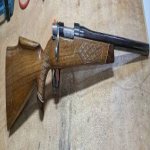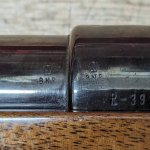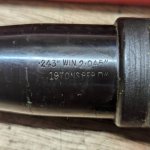So a friend picked up a mod 1200? PH in a Safari stock, serial number prefix comes up 1936-7 but the barrel is a heavy ( 3/4 inch at the muzzle) 24 inch .243 1 in 9.5 twist, now 243 wasn't played with till the 40s and not the market till mid 50s. The blueing on the action and barrel is a match. The barrel is stamped Parker Hale Bingham England on top. Custom, production re-run? Any answers or ideas from you wise men is appreciated.
You are using an out of date browser. It may not display this or other websites correctly.
You should upgrade or use an alternative browser.
You should upgrade or use an alternative browser.
Parker Hale 1936-7 243 heavy barrel question
- Thread starter MRP
- Start date
maple_leaf_eh
CGN Ultra frequent flyer
From my understanding, the British were thoroughly engrossed in all-things Lee Enfield in the 1930s. The model 1200 is a Mauser derivative, a very postwar innovation for commercial purposes. Yes, .243 was developed post war from the .308 Win, which itself derived from the .30-06 for NATO issue.
I think you are leaning too heavily on the serial number for your identification, and should be content that you have a modern postwar rifle.
I think you are leaning too heavily on the serial number for your identification, and should be content that you have a modern postwar rifle.
- Location
- Western Manitoba
Is typical on the many Parker Hale rifles here, that the Birmingham Proof House stamp code is on the barrel - usually about the chamber area - sometimes on bottom under the wood - part of that code provides the year that the assembly was proofed. PM to me if you need further details. Was "common" in old days to swap barrels - many folk REALLY good at finish - visually impossible to tell difference with some - home work versus factory job.
Many earlier Parker Hale rifles were built from previously existing Mauser actions - so date that receiver was made (based on serial number on the receiver), may not have much to do with when that rifle was put together, or if or when it was re-barrelled.
It is/was typical that every gun sold to a consumer - made in Britain or Europe (at home or in a factory) - required to go through a gov't proofing - their laws - was never a thing in USA or Canada - so will see many North American home-done things with no markings to show they had been altered.
Many earlier Parker Hale rifles were built from previously existing Mauser actions - so date that receiver was made (based on serial number on the receiver), may not have much to do with when that rifle was put together, or if or when it was re-barrelled.
It is/was typical that every gun sold to a consumer - made in Britain or Europe (at home or in a factory) - required to go through a gov't proofing - their laws - was never a thing in USA or Canada - so will see many North American home-done things with no markings to show they had been altered.
Last edited:
So maybe it's a 1100 not sure how to tell the difference. Under the barrel next to the action is stamped •243" WIN 2•045"
Ok wasn't thinking that is a 243 case length.
1100's came even later. Any chance of some pics? - dan
Parker Hale built up sporting rifles using M98 Mauser actions from different sources. It is entirely possible that the receiver was from a rifle built in the late 30s.
They went to sourcing actions/barreled actions out of Spain. I believe some of the reworked military actions were Spanish in origin. The ex-service actions stand out because of the thumb cutout on the left receiver wall for charger loading. PH transitioned to a Spanish made version of the FN commercial Mauser action. There are at least three versions of these commercial actions, with a C internal collar, ( ) partial collar and no collar at all. The latter have the same simplified pattern of bolt release/ejector as the Midland 2100 actions.
They went to sourcing actions/barreled actions out of Spain. I believe some of the reworked military actions were Spanish in origin. The ex-service actions stand out because of the thumb cutout on the left receiver wall for charger loading. PH transitioned to a Spanish made version of the FN commercial Mauser action. There are at least three versions of these commercial actions, with a C internal collar, ( ) partial collar and no collar at all. The latter have the same simplified pattern of bolt release/ejector as the Midland 2100 actions.
coyoteshooter
CGN Regular
- Location
- Ontario, Canada
hey......i have a 1200 p h in 243 got it in about 1970.never saw one till then ...my first accurate rifle....the h b of the time was rem 700 ...my ph shot and shoots as good or better than most of the day...trim and ream your cases ....i use a lee target set from the day...85 gr berger blc2 if i recall correctly.....clean the bore properly ....they are great guns.you will never go wrong with a mauser action. first rifle i ever bedded... could not get it out of the stock thought on it then took the scope off put it in the freezer for a day and it fell out....good luck don....speed is fine accuracy is final
Last edited:
Attachments
Last edited:
Any chance of letting us see the proof marks? On P-H rifles this is usually underneath the barrel in the vicinity of the action ring, also on the bolt and on the receiver. Three chances. Not sure that you wouldn't get a bigger audience by moving the post out of the black powder section of the site?
Just some comments on the PH rifles with SB made sporting style receivers...
The first ones had the full C style internal collar in the receiver ring. The only cut is to clear the extractor, so the action enjoys the benefit of Mauser's safety breeching. The second version yielded to manufacturing efficiency, and the left side bolt lugway is broached right through, so the collar is interrupted, with arches top and bottom. The final version has no internal collar, consequently no safety breeching.
I do not know when the receivers transitioned from machined forgings to finish machined castings.
I assume that the barrels were Spanish. In my experience, they are hard. Hammer forged. This opinion is based on machining them and on observations of mishaps resulting in barrel failure. Front sight ramps were secured by a single screw and two dowels. The three holes are close together, and wall thickness from the bottom of the holes to the bore is minimal. Fired with a muzzle obstruction, barrels would crack through the holes, and occasionally blow out pieces. Most other makes would simply bulge. The most dramatic example I observed was a .30-06 fired with its bore plugged with snow; the barrel broke into 7 pieces, all the way back to the receiver ring.
The stocks were made by Sile, in Italy.
Wood and metal finish was very well done, and the rifles are accurate.
The detachable box magazine version is clever, from the standpoint of altering the design to accept a detachable magazine, but is otherwise a mickey mouse abomination. If you have a "C" model, don't lose the magazine. Treasure it, because if you lose it, it will take a small fortune to buy a replacement.
The first ones had the full C style internal collar in the receiver ring. The only cut is to clear the extractor, so the action enjoys the benefit of Mauser's safety breeching. The second version yielded to manufacturing efficiency, and the left side bolt lugway is broached right through, so the collar is interrupted, with arches top and bottom. The final version has no internal collar, consequently no safety breeching.
I do not know when the receivers transitioned from machined forgings to finish machined castings.
I assume that the barrels were Spanish. In my experience, they are hard. Hammer forged. This opinion is based on machining them and on observations of mishaps resulting in barrel failure. Front sight ramps were secured by a single screw and two dowels. The three holes are close together, and wall thickness from the bottom of the holes to the bore is minimal. Fired with a muzzle obstruction, barrels would crack through the holes, and occasionally blow out pieces. Most other makes would simply bulge. The most dramatic example I observed was a .30-06 fired with its bore plugged with snow; the barrel broke into 7 pieces, all the way back to the receiver ring.
The stocks were made by Sile, in Italy.
Wood and metal finish was very well done, and the rifles are accurate.
The detachable box magazine version is clever, from the standpoint of altering the design to accept a detachable magazine, but is otherwise a mickey mouse abomination. If you have a "C" model, don't lose the magazine. Treasure it, because if you lose it, it will take a small fortune to buy a replacement.












































































